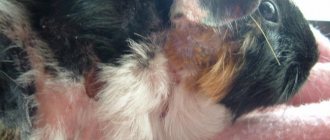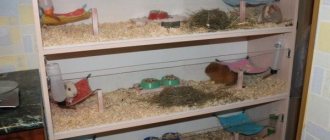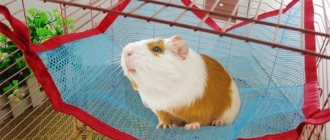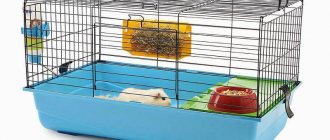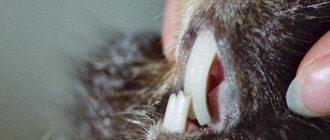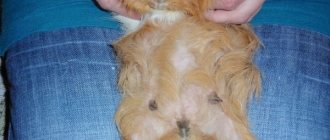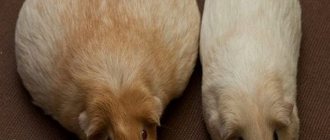A hay box for guinea pigs is a necessary piece of furniture for the animal’s home. All pigs, regardless of their breed and variety (hairless, fluffy, etc.), need to consume a portion of fresh hay every day. But you can’t just spread grass at the bottom of the cage - the animal will stain the food, and its diet should not contain contaminated foods, otherwise such a diet will have a detrimental effect on the pet’s health. To give the pig access to hay, but at the same time keep it clean, rodent owners use a special device - a hay barn.
Benefits of hay for guinea pigs
Since guinea pigs are herbivores, their digestive system is specially adapted to digest coarse fibers. With their deficiency, intestinal motility slows down, food stagnates in it, begins to rot and ferment, causing flatulence and intoxication of the whole body. Therefore, plant fiber, the main source of which is hay and grass, should be present in the diet of rodents daily.
In addition to fiber, good hay contains carotene, as well as other vitamins and minerals.
Important! Females should be given special “vitamin hay” during the period of bearing and feeding their offspring. It is obtained by shade drying the stems of alfalfa, clover and nettle. This hay is also beneficial for sick animals.
Necessary materials for sewing a hammock
To make a hanging device you will need materials and tools from this list:
- – durable fabric for the base, such as denim, cotton or fleece;
- – interlayer fabric, flannelette, padding polyester or fleece;
- – scissors, needles, threads, pencil, ruler;
- – a carabiner, ribbon or strip of dense fabric for attaching to the bars of the cage;
- – ribbons or buttons to decorate the product.
To make a tunnel-house you will need cardboard.
Selecting quality food
When purchasing food at a pet store, you should understand which hay is best for your guinea pig and what parameters you need to pay attention to:
- The hay should have a characteristic aroma for this type of grass. The presence of the smell of mold and synthetic substances indicates a violation of storage conditions.
- The hay should not be dusty.
- Hay should not contain foreign impurities, hay dust, insect pests and large stems with sharp edges.
- Hay from plantain leaves should not crumble when touched and turn into powder. This happens when the shelf life of the feed exceeds 7 months.
- The hay should not be wet. With high humidity, pathogenic mold fungi quickly develop in it, which causes poisoning in guinea pigs. Hay with signs of rotting is also unsuitable.
- The color of the hay should match the color of the grass. In most cases, the natural tone is green. Brown, yellow or black stems indicate exceeding the shelf life and loss of quality characteristics of the feed.
Owners who decide to make hay for their pets themselves must adhere to the following rules:
- plants for drying should be collected in areas remote from large cities, away from highways and industrial enterprises;
- you cannot collect grass from the pasture;
- herbaceous parts of plants should not be affected by pests and diseases;
- The stems and leaves of the plants should be green and not dried out.
When making hay for guinea pigs, the following herbs should not be used:
- celandine;
- spurge;
- hawthorn;
- lily of the valley;
- plants of the nightshade family;
- horsetail;
- hemlock.
The collected grass must be laid out on cloth or white sheets of paper in a ventilated, dark room.
Important! You should not use newspaper for drying, the printing ink of which can get on the plants and subsequently cause allergies or poisoning in the guinea pig.
To ensure even drying, plants should be carefully turned over. After the color of the stems has faded and they have become brittle, the hay is folded in portions into fabric bags, which are stored in a dry room.
Important! For guinea pigs with long hair, the hay should be cut, and before serving, the blades of grass folded together should be tied in the middle. This will make it easier to care for the coat and help avoid difficulties when combing.
Making a rectangular hammock
To sew a rectangular hanging shelf, two rectangles are cut out of durable fabric. The optimal length of the rectangle is 40–45 cm, width – 30–35 cm. The fabric for the interlayer is cut out to the same size.
Next, lay the fabric right side up, place a second rectangle on it, wrong side up, and a layer on top of it. All these layers are sewn together, inserting ribbons in the corners for fastening and leaving free space for turning the product right side out.
After stitching, the product is turned inside out. As a decoration, a ribbon or braid is sewn at the seams.
Tapes for loops should be made of durable, non-stretchy material so that the pig does not spring back when climbing or jumping off it.
For attachment to the cage, holes can be made in the corners of the hammock. It is better if the edges of the holes are processed or made with a grommet. In this case, the product will last longer and will be easier to remove for cleaning.
How to make a sennik with your own hands
Anyone can make a hay barn with their own hands from scrap materials. It can be replaced when it gets dirty or loses its appearance.
From a cardboard box
To make a hay box, you should take a rectangular cardboard box. Approximate dimensions:
- length - 20 cm;
- width - 10 cm;
- height - 5–7 cm.
These parameters may vary depending on the size of the cage.
Scheme for making a hay barn:
- The top of the box can be cut off completely. But some owners advise making a “closing window” for placing hay so that it does not stick out or fall out.
- It is best to strengthen the sides and glue them with a second layer of cardboard.
- Cut holes on one of the long sides through which it will be convenient for guinea pigs to get the hay.
- On the opposite side make 2 or 4 holes for fastening.
- Pull a flexible wire through them and secure the hay bar to the cage lattice.
A hay box made from a cardboard box is short-lived, as guinea pigs chew off the edges and the hay begins to fall out. Therefore, it should be replaced as needed.
Made from plywood and wood
A guinea pig kennel made of plywood or wood will last longer than its counterpart made of cardboard or fabric. It may look like a box without a top with three sides. Also, one of the walls of the feeder can be made of wooden rods.
Parts cut from wood can be glued or connected using grooves. The finished product is secured to the cage lattice with special hooks or loops.
Important! You should not place a wooden haybox on the floor of the cage, as the wood will gradually absorb urine, swell and emit an unpleasant odor.
From fabric
A fabric kennel for guinea pigs resembles a small shopping bag. The algorithm for its production consists of the following stages:
- take 2 identical pieces of dense fabric, the dimensions of which are approximately 20x20 cm;
- make 2 round or square holes in one of the flaps, the edges of which should be processed with a stitch or overlock;
- Fold the flaps right sides inward, sew them up on three sides and turn them inside out;
- Fold the free edge and stitch;
- sew 2 handles from laces or twisted threads;
- fill the bag with hay and secure it to the cage bars.
Important! If you fill the bag with dry grass and sew it up on all sides, you will get a toy for a guinea pig. The bag can be replaced with a sock.
From a plastic bottle
One of the simplest options for making a pet feeder is to use a plastic bottle.
A rectangular hole should be made in the side of a 1 liter bottle for placing hay. If the bottle has transverse grooves, you can use twine to secure it to the cage. You can also thread twine or soft wire through the holes in the bottom and cap of the bottle.
From other available means
You can easily make your own guinea pig feeder from a plastic container.
Important! The hay container must be made of food-grade plastic.
The container can simply be attached to the cage bars with large clothespins. You can also use wire or twine.
A paper towel cylinder is suitable as a temporary option for a hay barn. Several holes should be made in it and string should be threaded to secure it to the cage.
The hay box will greatly facilitate the care and maintenance of the guinea pig, and will also reduce the consumption of hay, as it will prevent the pet’s feces from getting into it, which causes the dried grass to rot and the appearance of an unpleasant odor in the room.
What is sennitsa?
Sennitsa is intended for dry grass and hay, which is used to normalize the functioning of the digestive tract of rodents, provide mechanical saturation, and enrich the chinchillas’ body with useful elements. It will not be possible to scatter food in the cage, because animals defecate where it is convenient for them and can easily spoil the food, so it is important to fix the dry grass in one place and on a hill. To prevent it from lying all over the enclosure, a convenient retainer is installed - a sennitsa, which must meet certain requirements.
Basic requirements for sennitsa:
- The accessory does not create traumatic situations. It is important to ensure safety for your pet so that he cannot get hurt on it or get stuck in the net.
- The food is securely fixed and does not fall out on its own, clogging everything around.
- The chinchilla has easy access to hay and gets it out on its own with ease.
- The possibility of defecation on the hay is excluded. Here it is important to properly secure the device so that your furry pet cannot perform this procedure.
There are two types of canopies according to the method of fastening: external and internal. Each modification has its own pros and cons, features of operation and choice. The safest type is considered to be an external device, since it does not create traumatic situations and does not take up much space in the enclosure. You can purchase and install an internal version, but it must be made of
metal (galvanized stainless steel is best) and closes well.
The most popular variation is the sennitsa in the shape of a metal ball made of wire, which is found in all pet stores. A significant drawback of this design is that the chinchilla can get stuck between the bars while trying to get food. To remove the animal, you will have to make considerable efforts.
Drinking bowl
A drinking bowl for a chinchilla must meet certain requirements: be closed, have enough volume, and be securely fastened. The most successful option are automatic drinkers or nipple-type drinkers. They allow you to keep water clean and fresh for several days.
Making a drinking bowl at home
You can make a drinking bowl for a rodent with your own hands from a bottle of saline solution. In addition to the bottle, you need to have a pipette tube and a small piece of wire. Manufacturing begins by removing the rubberized cap from the bottle and making a hole in it at a slight angle. The diameter of the hole should be slightly smaller than the diameter of the pipette - this way it will fit more tightly into it. Insert the pipette. The bottle is wrapped with wire and attached to the outside of the cell so that the tip of the pipette is inside the cell. It is better to fix the drinker at an acute angle - this way water will not drip to the bottom of the cage.
Tips for use
The installation height of the soft shelf is a very important factor. It should be comfortable for the pig to climb into it. And in the event of a fall, the animal should not be injured. Therefore, it is recommended to hang the device at a height of 6 cm to 15 cm from the bottom of the cage.
The dimensions of the product should allow the pet to rest freely on it.
The fabric of the product must be durable. Choose fleece or denim.
The hammock will last longer if there are no threads sticking out of the seams. The pig can chew on these threads, and the product can unravel.
Making a corner hammock
To sew a triangular hammock you need to take the appropriate measurements. Let's imagine that the triangle is inscribed in the corner of the cell. The legs of this triangle will lie on adjacent sides of the cage, and the hypotenuse will be the longest side of the triangle, which is located between the adjacent walls of the cage. The legs should be from 40 to 45 cm, respectively, the hypotenuse from 50 to 55 cm.
Next, you need to cut two triangles from the main fabric and from the interlayer. Sew them together with the outer sides facing each other, inserting ribbons into the corners for fastening and leaving room for turning them inside out. The layer should be adjacent to one of the main fabrics. Then the product is turned inside out so that the interlayer is inside.
In the corners of the triangle, you can use a grommet machine or scissors to make holes for installing fasteners. Strong cords, ribbons or carabiners are inserted into the holes.
A variation of the corner bed is the option with a hanging approach. A rectangle is sewn to the long side of the triangle, which is not attached to the walls of the cage. He is left hanging. It makes it easier for your pet to climb onto his bed. You can also initially cut out the parts, already taking into account the soft ramp.
Popular types
There are several types of feeders, but the most common are external and internal hay feeders. Let's look at each of them.
External hay mangers should be attached to the part of the cage in which the feed tray is planned to be placed. The feeder is usually represented by a box, a bottom and three wooden or metal walls. To make the fourth wall, a coarse mesh is used. The cover can be attached using hinges. Sometimes there are completely open structures. The choice of type of structure depends on where the nursery is located - indoors or outdoors. If a drinking bowl is adjacent to the cage, then the feeder is located on the other side.
Domestic
If the design of the cage does not allow connecting the feeder from the outside, an internal hay rack comes to the rescue.
Menu of a pregnant female
The diet of an animal expecting cubs does not differ significantly from the diet of others. Veterinarians insist on increasing the protein content in food. If the female begins to drink and eat much more, then this is normal. After all, another living creature is forming and developing inside it, which also needs to be fed. The main thing: the expectant mother is prohibited from overfeeding, otherwise obesity and health problems cannot be avoided. Also, the animal’s menu should be supplemented:
- sprouted grain. Reproductive function will return to normal due to the vitamin E content in complementary foods;
- food of animal origin. You'll have to go to the pet store to get it;
- calcium Once a day, a quarter of a tablet will help the expectant mother replenish the supply of this microelement, since the baby “takes” it from the female;
- apple Every day, 3 weeks before giving birth, it is worth introducing an eighth of the fruit into the diet of a pregnant animal;
- beebread. A couple of balls a day will have a beneficial effect on the health of both;
- alfalfa and strawberry leaves, flax seeds and rose hips, calendula flowers and oatmeal. They will bring the rodent's lactation to the required state.
It is important to exclude mint, thyme and lemon balm from the diet of a pregnant female.
Feeder for chinchillas: what are they?
A wide range of feeders requires you to familiarize yourself with the standards that the ideal choice meets before purchasing:
- Material. Edible plastic is excluded as it will not last long. Experts recommend choosing bowls made of metal, ceramics or glass.
- Form. A stable container firmly placed on the floor will do. A hanging feeder will be quickly removed from the bars by the chinchilla, and the food will be scattered throughout the cage.
- Fastening. The item must be securely attached to the cage, since rodents often turn over containers.
An automatic chinchilla feeder is more expensive, but solves several problems at once:
- Easily integrated into the cage.
- Determines the feed rate;
- Cannot be used as a toilet;
- Does not involve debris.
- Makes cleaning easier.
Feeder for chinchillas: what are they?
The choice of feeders in the pet store is large, so before purchasing you should familiarize yourself with the parameters that the ideal solution meets:
- material. Plastic is excluded, it will be eaten along with the food in a short time. Experts advise choosing metal bowls, although you can consider glass or ceramic;
- form. It is important to purchase a stable container that can be placed on the floor. The chinchilla will remove the hanging structure from the bars and scatter pieces of food throughout the cage;
- fastening. The feeder must be firmly attached to the cage - rodents love to play with containers, turning them over.
A ceramic feeder can be original.
An automatic feeder will cost a little more, but solves many problems:
- simply integrated into the cell;
- doses the amount of feed;
- a rodent cannot use it instead of a toilet;
- the ingress of debris is virtually eliminated;
- in this case, cleaning the cage is simplified.
